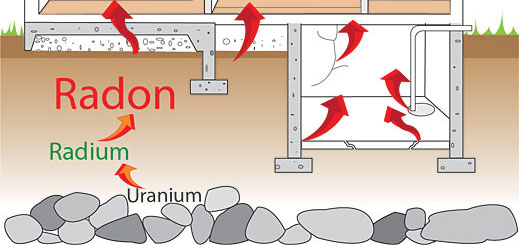What is Radon?
Radon is a naturally occurring invisible, odorless, tasteless gas that is emitted from the ground and can be found anywhere with no real rhyme or reason to where it may turn up. The gas derives from the natural breakdown (radioactive decay) of uranium and is usually found the igneous rock and soil and in some cases may be found in well water. As a result Radon levels can vary greatly in different areas, towns and even neighborhoods. It enters into your home through cracks in the concrete foundation or through the dirt floor of a basement, thus levels are often highest in basements in and crawl spaces. According to the EPA, Radon is the second leading cause of lung cancer and the leading cause of lung cancer among non-smokers. There are no immediate reactions to Radon and typically it takes years of exposure for problems to arise.
Radon Testing
Testing for Radon is a fairly simple process and test kits are readily available at most home improvement and hardware stores. If you are purchasing a new home and having a home inspection, your home inspector should be able to provide you with a radon test kit during the inspection. Even if you have lived in your home for several years, it is a good idea to test as radon gas as it can become prevalent even if there was none when you first purchased the home, especially if you have made any home improvements since you purchased the property. Test kits should be placed in the lowest level of the home, preferably in an area that will get the most use such as a finished area of the basement. The EPA recommends that if radon levels come back higher than 4 picocuries per liter (pCi/L) that you take action reduce the amount of radon gas present. Luckily, radon mitigation is fairly easy to do in most cases and can be done at a fairly reasonable cost.
Radon Mitigation and Removal
Essentially the basic function of radon remediation involves drawing air out of the basement and releasing it outside of the home. The most common Radon mitigation involves drilling a hole through the concreate foundation and then running a PVC pipe up through a pathway in the home like the attic or out through the side of the property and out to above the roof of the home. A fan is connected to the PVC piping that draws air from the hole that was drilled in the basement creating suction or vacuum like pressure in the soil below the foundation to pull the gas up from the ground and out through the top of the pipe elevated above the home. Depending on the home, other types of mitigation may be necessary to resolve the issue.
It is always best to consult with a certified radon mitigation contactor to advise you on what the best solution is as there are many factors that will attribute to choosing the proper type of mitigation system and to ensure it is properly installed and meets local building codes. A knowledgeable mitigation contractor will be able to assess how large a fan is necessary, the proper location of the where the system should be placed, or if multiple draw points are necessary as the type of underlying soil and size of the home will play a major factor in determining these things. Typically radon mitigation systems can be installed in just a few hours and it is something that could be done by a knowledgeable do-it-yourselfer at a fairly low cost.
For more information about Radon gas you can visit these websites here.
http://www.cancer.org/cancer/cancercauses/othercarcinogens/pollution/radon
http://www.cdc.gov/nceh/radiation/brochure/profile_radon.htm
I service Real Estate sales in the following Metrowest and Worcester area towns: Acton, Ashland, Auburn, Bellingham, Bolton, Boylston, Dudley, Framingham, Grafton, Holden, Hopkinton, Hudson, Leominster, Lancaster, Marlborough, Maynard, Millville, Mendon, Milford, Millbury, Northborough, Natick, Oxford, Shrewsbury, Sterling, Stow, Sturbridge, Sutton, Upton, Uxbridge, Westborough, West Boylston, Worcester MA
